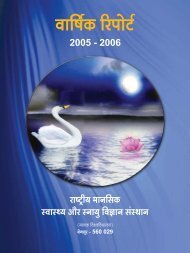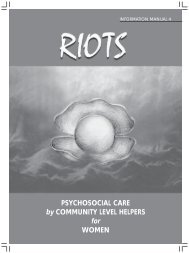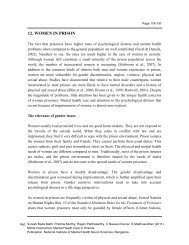An illicit alcohol production center in rural Bangalore - Nimhans
An illicit alcohol production center in rural Bangalore - Nimhans
An illicit alcohol production center in rural Bangalore - Nimhans
Create successful ePaper yourself
Turn your PDF publications into a flip-book with our unique Google optimized e-Paper software.
1. Prevalence of <strong>alcohol</strong> use <strong>in</strong> Karnataka<br />
Alcohol use is low<br />
Only 15% of all the adults sampled over 5 districts <strong>in</strong> Karnataka reported any <strong>alcohol</strong> use over the<br />
past 12 months. The low prevalence of <strong>alcohol</strong> users <strong>in</strong> this study sample is fairly similar to<br />
previously reported figures from epidemiological studies conducted over the past thirty years <strong>in</strong><br />
specific regions of India (Isaac,1998; Saxena, 1999).<br />
Surveys of Alcohol Use <strong>in</strong> the General Population <strong>in</strong> India<br />
Study Year Sample Area Population Measure Rate<br />
Lal and S<strong>in</strong>gh 1978 Rural Punjab 7000 Current <strong>alcohol</strong> use 49.6% adults<br />
Sethi and Trivedi 1979 Rural Uttar Pradesh Alcohol use 21.4% adults<br />
Varma 1980 Urban Chandigarh Ever Use<br />
40% adults<br />
Current use<br />
23.7%<br />
Mathrubootham 1989 Tamil Nadu Alcohol use 33% males<br />
Channabasavanna 1989 Karnataka 5573 students; Alcohol ever used 42.1%<br />
4007 adults<br />
33.7%<br />
NIMHANS 1990 Rural Karnataka 32,400 Alcohol dependence 1.15%<br />
Chakravarthy 1990 Rural Tamil Nadu Alcohol use 26-50%<br />
males<br />
Ponnudorai et al 1991 Urban Madras Current use 16.67<br />
males<br />
%<br />
Bang and Bang 1991 Rural Maharashtra 400,000 Use<br />
Addicted<br />
25% males<br />
5%<br />
Mohan et al 1992 Urban slum Delhi Substance abuse 26%<br />
Murthy et al 1998 Urban slum <strong>Bangalore</strong> 5633 Alcohol use 27% males;<br />
2% females<br />
There are extreme gender differences <strong>in</strong> the prevalence of <strong>alcohol</strong> use<br />
Alcohol use is still very much a male preserve. Only about a third of the men and as little as a tenth<br />
of the women reported any <strong>alcohol</strong> use with<strong>in</strong> the past year. This is compatible with previous<br />
estimates of use from the same region as well as other parts of the country, which have consistently<br />
reported female use less than 5% [Isaac. 1998; Saxena, 1999]. One must note here that figures<br />
perta<strong>in</strong><strong>in</strong>g to female use are liable to be under-reported. Alcohol use and especially <strong>alcohol</strong> use <strong>in</strong><br />
women is socially stigmatized and there is a reluctance to report such use. There is some support<br />
for this view, as a significant number of male and female users expressed the view that womens’<br />
dr<strong>in</strong>k<strong>in</strong>g is viewed as somehow more shameful and therefore kept hidden. Even among consumers<br />
there is a belief that women dr<strong>in</strong>k rarely and <strong>in</strong> small amounts, which is far from what actually<br />
transpires [see below].<br />
It should be noted that, identification of users was primarily conducted through <strong>in</strong>itial <strong>in</strong>formation<br />
given by a key <strong>in</strong>formant <strong>in</strong> each family, who was most often (for reasons of social propriety) the<br />
male head of house-hold. Under these circumstances there is likely to be a greater chance of underestimat<strong>in</strong>g<br />
consumers among the female family members and <strong>in</strong> the younger males as well. The<br />
former would be “protected” from enquiry and the latter would be likely to have hidden their status<br />
as consumer from the family.<br />
74





